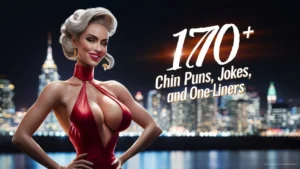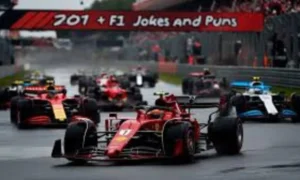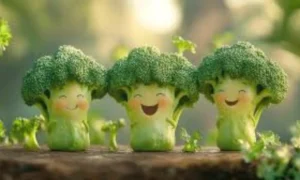Art is a universal language that transcends borders and cultures, offering a glimpse into the human soul and the creative spirit. Dive into the colorful and fascinating world of art with these 101 surprising fun facts.
1. 🎨 Ancient Art: Timeless Creations
- The earliest known cave paintings date back to 40,000 years ago.
- Lascaux Cave in France is famous for its prehistoric art.
- Egyptian art was highly stylized and symbolic.
- The Venus of Willendorf, a prehistoric figurine, dates to around 25,000 BCE.
- Greek sculptures emphasized realism and idealized forms.
- The Parthenon Marbles are masterpieces of classical Greek art.
- Roman mosaics were used to decorate floors and walls.
- Byzantine art featured religious themes and mosaics.
- Chinese brush painting dates back over 2,000 years.
- The Nazca Lines in Peru are massive geoglyphs visible from the air.
2. 🎨 Renaissance Art: The Rebirth of Creativity
- The Renaissance began in Italy in the 14th century.
- Leonardo da Vinci was a polymath and master painter.
- Michelangelo sculpted the iconic statue of David.
- Raphael was known for his harmonious compositions.
- Botticelli painted “The Birth of Venus”.
- Brunelleschi developed linear perspective in art.
- Titian was a leading figure in Venetian painting.
- Donatello revived classical sculpture techniques.
- The Sistine Chapel Ceiling was painted by Michelangelo.
- The Mona Lisa by Leonardo da Vinci is one of the most famous paintings in the world.
3. 🎨 Baroque and Rococo: Drama and Ornamentation
- Caravaggio used dramatic lighting and realism.
- Bernini was a master of Baroque sculpture.
- Rembrandt is known for his use of light and shadow.
- Peter Paul Rubens created dynamic, energetic compositions.
- Diego Velázquez painted the Spanish royal family.
- Rococo art is characterized by ornate detail and light colors.
- Fragonard painted “The Swing”.
- Boucher was known for his sensual Rococo paintings.
- Vermeer captured domestic scenes with incredible detail.
- Poussin focused on classical themes and order.
4. 🎨 Impressionism: Capturing the Moment
- Claude Monet painted “Impression, Sunrise”.
- Edgar Degas depicted ballerinas and dancers.
- Pierre-Auguste Renoir focused on light and color.
- Camille Pissarro is considered the “father of Impressionism”.
- Mary Cassatt highlighted the lives of women and children.
- Berthe Morisot was a leading female Impressionist.
- Alfred Sisley specialized in landscape painting.
- Gustave Caillebotte painted urban Parisian life.
- Impressionism emphasized painting outdoors (en plein air).
- The movement was initially criticized but later celebrated.
5. 🎨 Post-Impressionism: Beyond the Brushstrokes
- Vincent van Gogh painted “Starry Night”.
- Paul Cézanne influenced modern art with his structured brushstrokes.
- Georges Seurat developed pointillism.
- Paul Gauguin explored exotic themes and bold colors.
- Henri de Toulouse-Lautrec captured Parisian nightlife.
- Émile Bernard was a close friend of van Gogh.
- Henri Rousseau created dreamlike jungle scenes.
- Camille Pissarro was also a post-impressionist.
- Pierre Bonnard used vibrant colors and intimate subjects.
- Post-Impressionism paved the way for modern art movements.
6. 🎨 Modern Art: Breaking Boundaries
- Pablo Picasso co-founded Cubism.
- Wassily Kandinsky is credited with creating the first abstract painting.
- Marcel Duchamp challenged art conventions with “Fountain”.
- Piet Mondrian developed neoplasticism.
- Salvador Dalí was a leading figure in Surrealism.
- Jackson Pollock is known for his drip paintings.
- Andy Warhol was a pioneer of Pop Art.
- Frida Kahlo painted deeply personal and symbolic works.
- Henri Matisse used bold colors and simple forms.
- Georgia O’Keeffe is famous for her large-scale flower paintings.
7. 🎨 Contemporary Art: Reflecting Today’s World
- Yayoi Kusama creates immersive installations with polka dots.
- Damien Hirst is known for his controversial pieces.
- Banksy is a renowned street artist.
- Jeff Koons creates large-scale, shiny sculptures.
- Ai Weiwei combines art with political activism.
- Cindy Sherman explores identity through photography.
- Marina Abramović is a pioneer of performance art.
- Anish Kapoor creates monumental sculptures.
- Kara Walker addresses race and history in her silhouettes.
- Takashi Murakami blends pop culture with fine art.
8. 🎨 Famous Art Museums: Homes of Masterpieces
- The Louvre in Paris is the world’s largest art museum.
- The Metropolitan Museum of Art in New York City has over 2 million works.
- The British Museum in London is famous for its extensive collections.
- The Vatican Museums house the Sistine Chapel ceiling.
- The Rijksmuseum in Amsterdam features Dutch masters.
- The Prado Museum in Madrid has an impressive Spanish art collection.
- The Hermitage Museum in Saint Petersburg is one of the largest.
- The National Gallery in London showcases Western European art.
- The Uffizi Gallery in Florence is a Renaissance art haven.
- The Museum of Modern Art (MoMA) in New York City focuses on contemporary art.
9. 🎨 Art Movements: Evolution of Styles
- Renaissance: Revival of classical learning and wisdom.
- Baroque: Drama, tension, and exuberance.
- Rococo: Ornate, decorative, and light-hearted.
- Neoclassicism: Inspired by classical antiquity.
- Romanticism: Emphasis on emotion and individualism.
- Realism: Depiction of everyday life and subjects.
- Impressionism: Focus on light and color.
- Expressionism: Emphasis on emotional experience.
- Cubism: Abstract forms and fragmented objects.
- Surrealism: Dream-like, fantastical imagery.
10. 🎨 Art Techniques: Tools of the Trade
- Oil painting: Slow-drying, versatile medium.
- Watercolor: Transparent and fluid.
- Acrylic: Fast-drying and flexible.
- Charcoal: For bold, expressive lines.
- Ink: Used for precise, detailed work.
- Pastel: Soft and vibrant.
- Collage: Assemblage of different materials.
- Sculpture: Three-dimensional art form.
- Printmaking: Creating multiple copies of an artwork.
- Digital art: Created using computer software.
11. 🎨 Art Supplies: Essential Tools for Creators
- Canvas: A surface for painting.
- Brushes: Different shapes and sizes for various effects.
- Palette: For mixing paints.
- Easel: Holds the canvas upright.
- Pencils: For sketching and drawing.
- Eraser: To correct mistakes.
- Palette knives: For mixing and applying paint.
- Fixative spray: Protects charcoal and pastel drawings.
- Drawing paper: Various textures for different media.
- Gesso: Primer for canvas.
12. 🎨 Art Galleries: Showcasing Talent
- The Saatchi Gallery in London.
- The Gagosian Gallery has locations worldwide.
- The David Zwirner Gallery in New York.
- The White Cube in London.
- The Tate Modern in London.
- The Guggenheim Museum in New York.
- The Centre Pompidou in Paris.
- The Serpentine Galleries in London.
- The Whitney Museum of American Art in New York.
- The Almine Rech Gallery in Paris.
13. 🎨 Art Education: Learning the Craft
- Art schools offer formal training in various disciplines.
- Workshops provide hands-on learning experiences.
- Online courses make art education accessible.
- Art history classes teach about past movements and artists.
- Life drawing sessions improve figure drawing skills.
- Critique sessions offer feedback and growth.
- Artist residencies provide immersive creative environments.
- Museums often host educational programs.
- Art books and resources are valuable learning tools.
- Community centers often offer art classes.
14. 🎨 Famous Artists: Masters of Their Craft
- Leonardo da Vinci: The ultimate Renaissance man.
- Michelangelo: Sculptor of David and painter of the Sistine Chapel.
- Vincent van Gogh: Post-Impressionist master.
- Pablo Picasso: Co-founder of Cubism.
- Claude Monet: Father of Impressionism.
- Salvador Dalí: Surrealist icon.
- Frida Kahlo: Painter of personal and powerful works.
- Andy Warhol: Leader of the Pop Art movement.
- Henri Matisse: Known for his use of color.
- Georgia O’Keeffe: Famous for her flower paintings.
15. 🎨 Art in Culture: Influence and Impact
- Art reflects society and cultural values.
- Political art can influence change.
- Art therapy aids mental health.
- Public art beautifies communities.
- Fashion and design draw inspiration from art.
- Art in film enhances storytelling.
- Music and art often intersect.
- Literature and art have deep connections.
- Art festivals celebrate creativity.
- Art in advertising drives consumer engagement.
16. 🎨 Art and Technology: The Digital Age
- Digital painting allows for limitless creativity.
- 3D printing creates sculptures and models.
- Virtual reality offers immersive art experiences.
- Augmented reality enhances physical art with digital elements.
- NFTs (Non-Fungible Tokens) revolutionize art ownership.
- Art software like Adobe Photoshop expands possibilities.
- Online galleries showcase art globally.
- Social media connects artists and audiences.
- AI-generated art pushes creative boundaries.
- Digital installations create interactive experiences.
17. 🎨 Art in Different Cultures: A Global Perspective
- African art often uses masks and sculptures.
- Asian art includes calligraphy and ink painting.
- Indigenous art reflects cultural heritage.
- European art has a rich history from the Renaissance to modern times.
- Middle Eastern art features intricate patterns and designs.
- Oceanic art includes carvings and tattoos.
- Latin American art blends indigenous and colonial influences.
- Aboriginal Australian art uses dot painting.
- Russian art includes iconography and avant-garde movements.
- Indian art features vibrant colors and religious themes.
18. 🎨 Art Exhibitions: Bringing Art to the Public
- The Venice Biennale is a major international art exhibition.
- The Documenta in Germany showcases contemporary art.
- Art Basel is held in several cities worldwide.
- The Whitney Biennial features American artists.
- Frieze Art Fair takes place in London and New York.
- The Armory Show in New York focuses on modern and contemporary art.
- The São Paulo Biennial is a key event in Latin America.
- The Berlin Biennale explores contemporary issues.
- The Istanbul Biennial highlights global art trends.
- The Sharjah Biennial in the UAE promotes Middle Eastern art.
19. 🎨 Art Collecting: Building a Personal Gallery
- Start by buying what you love.
- Research artists and their work.
- Visit art fairs and galleries.
- Network with collectors and artists.
- Invest in emerging artists.
- Understand the market and trends.
- Protect your collection with proper storage and insurance.
- Document your collection for provenance.
- Consider online platforms for discovering art.
- Join collector groups and communities.
20. 🎨 Art Puns and Jokes: Lightening the Mood
- What did the artist say when he finished his painting? “It’s a masterpiece!”
- Why did the artist go broke? He had too many debts to canvas.
- What’s an artist’s favorite type of music? “Raphael” music.
- Why was the artist afraid he might go to jail? Because he had a brush with the law.
- What do you call a painting by a cat? A paw-trait.
- Why did the painting go to jail? Because it was framed.
- What did the artist say to the rival? “You can’t brush me off!”
- How do artists greet each other? “Draw me like one of your French girls!”
- What do you call an artist who sculpts with ice? A chill artist.
- Why do artists constantly feel cold? Because they’re surrounded by drafts.
Conclusion:
Art is not just about creating beautiful objects; it’s about expressing emotions, challenging perceptions, and connecting with others. Whether you’re an artist, a collector, or simply an admirer, the world of art offers endless possibilities for exploration and inspiration. From ancient cave paintings to contemporary digital art, each piece tells a unique story and contributes to our shared cultural heritage.

Ethan Richards is the mastermind behind laughter.com. Known for his quick wit and hilarious takes on everyday life, Ethan transforms the mundane into the extraordinary. Dive into his world and let Ethan’s humor bring a smile to your face.










